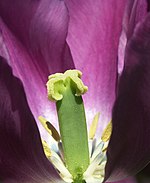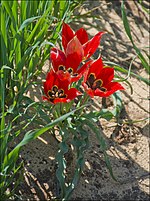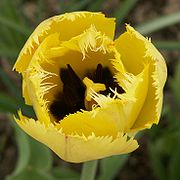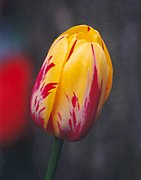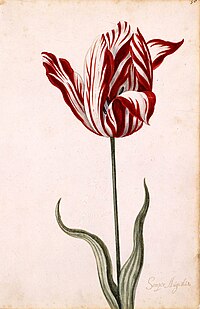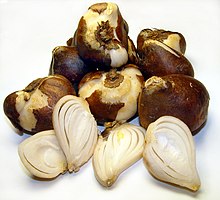Tulip
Tulipa is a genus of perennial and bulbous plants belonging to the Liliaceae family, which includes the popular tulips, common name with which all species, hybrids and cultivars of this genus are designated. Tulipa contains approximately 150 species and innumerable numbers of hybrids and cultivars achieved through genetic improvement that flower growers have been carrying out since the century XVI.
Etymology
The word "tulip" comes from the Ottoman Turkish word tülbend, which in turn comes from the Persian term dulband. Both words mean 'turban' and refer to the shape the flower takes when closed.
Origin and distribution
The center of diversity of the genus is found in the Pamir and Hindu Kush mountains in the steppes of Kazakhstan, being distributed throughout the Middle East, Iran and Afghanistan particularly, towards the Anatolian peninsula, southern Europe and North Africa, to the west, and to the northeast of China, to the east.
Tulips have been cultivated as ornamental plants since the early 11th century century in Anatolia. The bulbs taken by Ibn Massal from Toledo for cultivation in al-Andalus would come from this region and Iran, according to the work Umda by the botanist Abu-I-Jayr, dated between the 11th and 12th centuries., studied by researchers Esteban Hernández Bermejo and Expiración García. With the Modern Age, its cultivation spread to the countries of northern Europe, becoming the flower symbol of the Netherlands and an inseparable part of its landscape. It also has a use as a national symbol in Iran and Turkey.
Morphology
They are herbaceous and bulbous plants. The bulbs are basally truncate and elongated towards the apex, covered by a tunic usually hairy on the inside. The stem is simple (occasionally branched) and underground in its basal portion. The leaves are basal and cauline, spaced or more or less rosette, linear, ovate or lanceolate.
The flowers are actinomorphic and hermaphrodite, erect or, more rarely, pendulous, and are arranged in number from 1 to 3 at the extremity of the flower stalks. The perigonium is broadly funnel-shaped or bell-shaped, composed of free, subequal tepals, generally wide and imbricated, coloured, frequently with a minute tuft of white hairs at the apex. The androecium is made up of six even stamens, with flattened filaments and oblong anthers. The ovary is superior, trilocular, pluriovulate. The style is columnar or very short, the stigma is trilobed. The fruit is a loculicidal, multiseed capsule. The seeds are usually flat, subdeltoid.
Genetics
In general, all Tulipa species and cultivars are diploid with 2n=2x=24 chromosomes. The most conspicuous exception is the hybrid cultivars of the type called «Darwin», which are triploid with 2n=3x=36 chromosomes and, moreover, the product of a cross between two species: Tulipa fosteriana and T. gesnerian .
Taxonomy
The genus Tulipa has been subdivided into two subgenera based on morphological characters and compatibility patterns in interspecific crosses: Eriostemones and Tulipa (=Leiostemones). The subgenus Eriostemones consists of three sections, while Tulipa comprises five sections, as follows:
- Subgender Eriostemons, includes sections:
- Southern: T. australis, T. biebersteiniana, T. hageri, T. orphanidea, T. primulina, T. sylvestris and T. whittallii.
- Biflores: T. biflora, T. dasystemon, T. neustruevae, T. polychroma, T. sogdiana, T. delay and T. turkestanica.
- Saxatiles: T. aucheriana, T. bakeri, T. humilis, T. pulchella and T. saxatilis.
- Subgender Tulipa, includes sections:
- Clusianae: T. clusiana, T. linifolia and T. montana.
- Eichleres: T. albertii, T. dubia, T. eichleri, T. fosteriana, T. greigii, T. ingens, T. kaufmanniana, T. lanata, T. praestans, T. sosnovskyi, T. subpraestans, T. tschimganica and T. tubergeniana.
- Kolpakowskianae: T. altaica, T. lehmanniana and T. tetraphylla.
- Tulipa: T. armena, T. didieri, T. gesneriana, T. hungaryarica and T. softolens.
- Tulipanum: T. agenensis, T. aleppensis, T. julia, T. kuschkensis, T. praecox and T. systola.
The list of species of the genus, arranged alphabetically, can be consulted in the Annex: Species of Tulipa.
The garden tulip
The common or garden tulip (Tulipa gesneriana L.) and a number of other species, such as Tulipa bakeri, Tulipa clusiana, Tulipa fosteriana, Tulipa kaufmanniana and Tulipa tarda, as well as a vast number of complex hybrids between the species mentioned, are cultivated all over the world for their spectacular flowers. Due to interspecific hybridization, recombination, and selection, the botanical nomenclature of the cultivated tulip is extremely complicated, since none of the current cultivars, which present a great diversity of sizes, colors, and flower shapes, as well as flowering times, can be identified by the name of any of the wild taxa of the genus.
There are more than 5,000 registered cultivars of tulips. A classification of them has been carried out on the basis of the structure of the flowers, the flowering period and the origin. Some of the 15 commonly established groups are:
- Lirio flower tulips: they have typical teapals on the tip and turned to the outside.
- Darwin Hybrid Tulips: are among the largest and most visible flower tulips.
- Tulips double flower precoces: includes the tulips 25 to 40 cm high, with double flowers, often 6 to 10 cm wide and flowering between early and mid spring.
- Simple flower precocious tulips: it includes the tulips 25 to 60 cm high, with caliciform flowers, simple, that sometimes fade into the sun and bloom between the beginning and the middle of the spring.
- Papagayo tulips. They measure 45 to 60 cm tall and are similar to simple flower tulips, although the teapals are twisted, or their thick edges. They bloom from the middle of the spring.
- Tulips Rembrandt: they are similar to simple flower tulips but the teapals present a "rupture" of the basic color, in stretches or "souls" of different colors. This coloration is caused by the infection of a virus that can be transmitted by aphids. For this reason, varieties of this type are cultivated and multiplied separately from the remaining varieties of tulip.
- Tulips Triumph: includes those cultivars 25 to 40 cm high, with conical flowers covered by sturdy stems, quite weather resistant.
The color of the flower is determined by the composition and proportion of different pigments. Thus, the yellow flowers contain only carotenoids and cyanidin; the red ones, cyanidin and pelargonidin, and the purple ones, a combination of cyanidin and delphinidin. Pink flowers contain the greatest variation in pigment types, but their level or content is relatively less than that present in the other color types, while white flowers exhibit almost no pigment at all.
The following are images that exemplify some of the types of cultivars:
History of cultivation in the West
The traditionally most widespread versions of the origin of the ornamental cultivation of the tulip in the West maintain that it began with the importation of bulbs from the Ottoman Empire through Central Europe from the century XVI. Other studies also point to an earlier route of introduction into Europe, from the Byzantine Empire to al-Andalus in Muslim Hispania.[citation needed]
Another version indicates that the Austrian ambassador to Turkey, Ogier Ghislain de Busbecq, who was also an enthusiastic flower grower, saw tulips grown in Adrianople. In 1544, when he returned to Europe, he brought some bulbs with him to the Imperial Gardens in Vienna. Decades later, in 1593, Carolus Clusius left his work in the Imperial Gardens to take up the post of professor of botany in Leiden, the Netherlands, where he brought a collection of tulip bulbs that created great interest and enthusiasm..
Between 1610 and 1620 in France and by 1634 in the Netherlands, enthusiasm for growing these bulbous plants turned into a veritable fever known as tulip mania. Possessions of all kinds were sold to buy tulip bulbs and some rare types of this species cost the price of a farm, a house or several horses. In 1623, a single bulb of a famous variety of tulip could cost as much as 1,000 guilders—an exorbitant figure considering that the average annual profit at that time was 150 guilders. On the other hand, a good bulb merchant could earn 6,000 guilders per month. In 1635 there was a sale of forty bulbs for 100,000 guilders—for comparison purposes, a ton of butter cost approximately 100 guilders. A real record was the sale of the most famous bulb, "Semper Augustus", for 6,000 guilders in Haarlem.
There weren't enough bulbs on the market to support existing demand, so tulip mania turned into financial speculation, with investors buying and selling credit notes, not bulbs. This period of speculative euphoria gave rise to a great economic bubble and a financial crisis. It constitutes, in fact, one of the first speculative phenomena of money supply of which there is news.
World market
The tulip is cultivated with two main objectives: the production of cut flowers and dry bulbs. The latter are used, in turn, to satisfy the demand for bulbs for parks, gardens and home use and, on the other hand, to provide the necessary bulbs for the production of cut flowers. The international cut flower trade has a global value of approximately 11 billion euros, which provides a magnitude of the economic importance of this activity.
The main producing country of tulip bulbs is the Netherlands, a country that concentrates 87% of the world area, which is approximately 12,000 hectares. Bulbs of this species are produced significantly in 14 other countries, led by Japan, France and Poland. Most of these countries use the bulbs obtained for their own cut flower production or to supply their retail market with dried bulbs. The Netherlands, however, apart from being the main international producer of bulbs, is the exception to this generalization. In fact, it produces approximately 4 billion bulbs annually, of which 53% are used in the cut flower market and the remainder are used in the dried bulb market. Of the bulbs destined for the cut flower market, the Netherlands uses 57% to satisfy its internal market and the rest is exported to various countries, inside and outside the European Union.
Cultivation
Cultivation for bulb production
This type of culture is started from bulbils, which are produced around the original bulb and separated from it after harvesting. As in the production of other types of bulbs, a well-drained, sandy soil with a pH close to neutrality is required. Two years are needed to reach commercial size bulbs. In the first year, the bulbils are planted in autumn, at high densities (1-2 cm apart between bulbils) and bulbs of sizes 6-8, 8-10 are harvested. After collecting the bulbs in the summer, the second year of cultivation is carried out, at a lower density (4-5 cm of separation between bulbs), with the use of chemical fertilizers and other agrochemicals to protect the crop from pests and diseases. Harvesting begins when the tunic of the bulbs begins to colour. Harvested bulbs reach a caliber of 11-12 or higher.
Cultivation for cut flower production
This type of cultivation begins with the acquisition of commercial size bulbs (calibre 11-12 or larger) and planting them in the fall. Sandy, well-drained soils should be used. The bulbs are planted in rows with the bulbs spaced 5cm apart and 4-5cm deep. The harvesting of the flowers is carried out when the color of the petals is barely visible in the buds. For harvesting, the entire plant is usually uprooted (floral stem, bulb and root) and the floral pedicel is cut as close as possible to the base of the bulb in order to achieve longer "flowers", which are more appreciated by consumers. The floral stems are placed in containers with water inside refrigerated rooms at 4-5 °C until they are sold.
Contenido relacionado
Tumucumaque Mountains National Park
Lipid
Annonaceae

